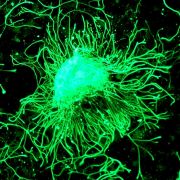Drawing Conclusions: Using Art to Fight Child Abuse
Is a picture worth only a thousand words? According to Dr. Carmit Katz of Tel Aviv University's Bob Shapell School of Social Work, illustrations by children can be a critical tool in forensic investigations of child abuse.
Dr. Katz's study, published in Child Abuse and Neglect, compared the results when child abuse victims were offered the opportunity to draw during questioning with victims not offered this opportunity. Her findings saw a significant difference, suggesting a therapeutic value and indicating that children empowered to draw pictures about their abuse provided much fuller and more detailed descriptions.
"The act of drawing was not only an empowering experience for these children," said Dr. Katz. "We also found it to be forensically more effective in eliciting richer testimonies in child abuse cases. We had no idea the gap would be so great between those who drew and those who weren't given this option."
A chance to express themselves
Some 125 alleged child victims of sexual abuse were randomly selected for the field study. The children, aged 5-14, were questioned by nine well-trained forensic interviewers about a single occurrence of alleged sexual abuse. The children were divided into two sets — a control group, questioned and allowed to rest during the session; and a variable group, offered the opportunity to draw pictures about their experiences for 7-10 minutes instead of resting.
The interviews in the study were conducted according to standard NICHD (National Institute of Child Health and Human Development International Evidence-Based Investigative Interviewing of Children) protocol, which dictates using open-ended questions to elicit more comprehensive testimonies.
"For example, we asked children to 'tell me again everything that happened to you,' without using any leading terms to steer the discussion," said Dr. Katz. "And we found that if that question was followed by the comment, 'You can use the drawing if you want to,' the child's testimony was substantially more comprehensive and detailed."
In the study, Dr. Katz worked with professional practitioners from Israel's Investigative Interview Service, which is considering incorporating her strategy into the standing NICHD protocol.
Empowering the victim
"As a social worker, I'm not only interested in obtaining accurate forensic results," said Dr. Katz. "I'm also interested in empowering the children. Through drawing, children reported regaining some sense of control — even feeling hopeful. This also has recuperative properties."
Dr. Katz has focused her research on turning the typically traumatic forensic interview into a first step toward recovery for child abuse victims, who reported feeling understood, successful and in control after drawing during the questioning. "The only thing that counts is the child's narrative and his or her narrative of the respective drawing," she said. "But forensic investigators must be very careful not to attribute meaning where none exists. For example, 'I see a penis in this drawing, please tell me about it,' is a projective strategy which usually garners false results. My strategy is to offer open-ended prompts alongside drawing, which we found to be a great facilitator of communication."
Dr. Katz is currently at work on a study of younger child abuse victims, aged 3-6, who experienced multiple incidents of abuse. She hopes to see her research fully integrated into the international NICHD protocol, the prevailing approach to investigating child abuse in most countries today.
As originally reported by AFTAU.






